Who has been doing way more cooking at home than usual?
Raises hand
We don’t do a lot of eating out or getting takeaways, but with all restaurants closed for the 4+ weeks of Level 4 lockdown in NZ, cooking every meal showed how much premade food we do eat – and how much work it is to plan every menu in advance because you can only go shopping once a week.
I don’t mind cooking. I do mind menu planning. Figuring out what to eat is hard work!
Here are some of our favourites which have been in heavy rotation in the last few months. Bonus: they are all vegetarian or vegan, which is great if you’re trying to lower your carbon footprint.
Spinach & Chickpea Curry
I’m obsessed with this curry. It only has one major flaw: it uses a weird amount of coconut milk, and then you are left with half a can of coconut milk, and have to figure out what to do with it.
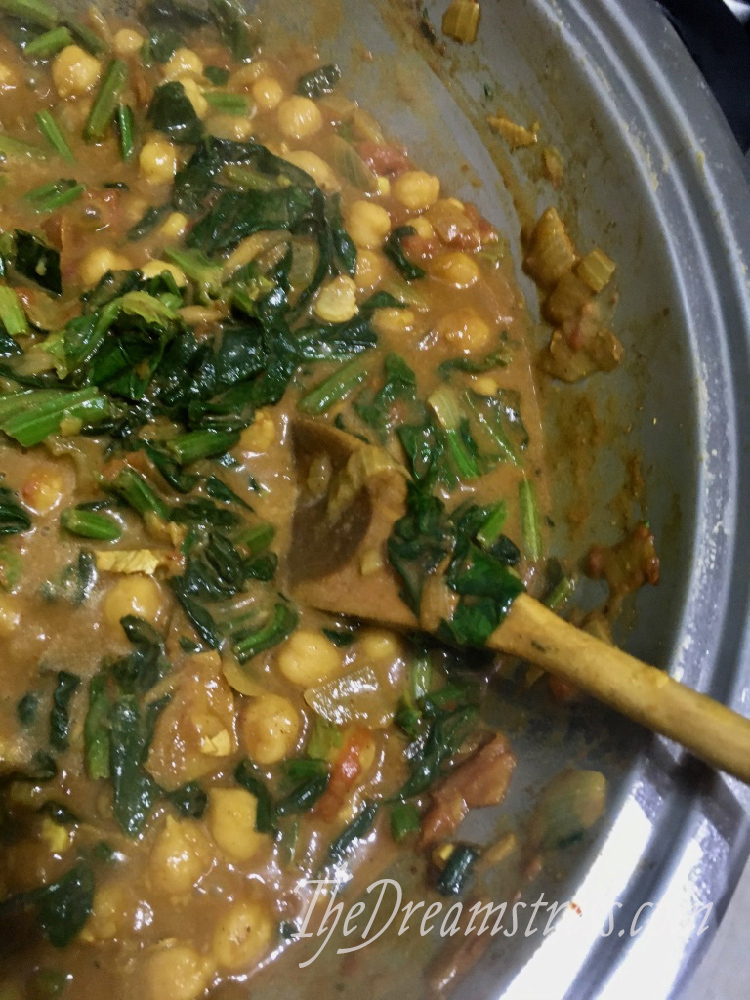
I always use fresh spinach, and more than the recipe calls for. I also tend to be quite liberal with my ginger. I’ve never added the sugar.
For this dish I cook up four servings of chickpeas in my pressure cooker at once, use one in it, refrigerate one or two for minestrone or Moroccan vegetable soup later in the week, and then freeze the remainder for times when I’m too busy to cook them fresh.
Minestrone Soup
We’ve had minestrone soup at least once a month for the last 10 years, and as far as I can tell I’ve never taken a photo of the finished dish! All I’ve got is this in-process photo, showing how I use wild garlic instead of onions when it’s available:
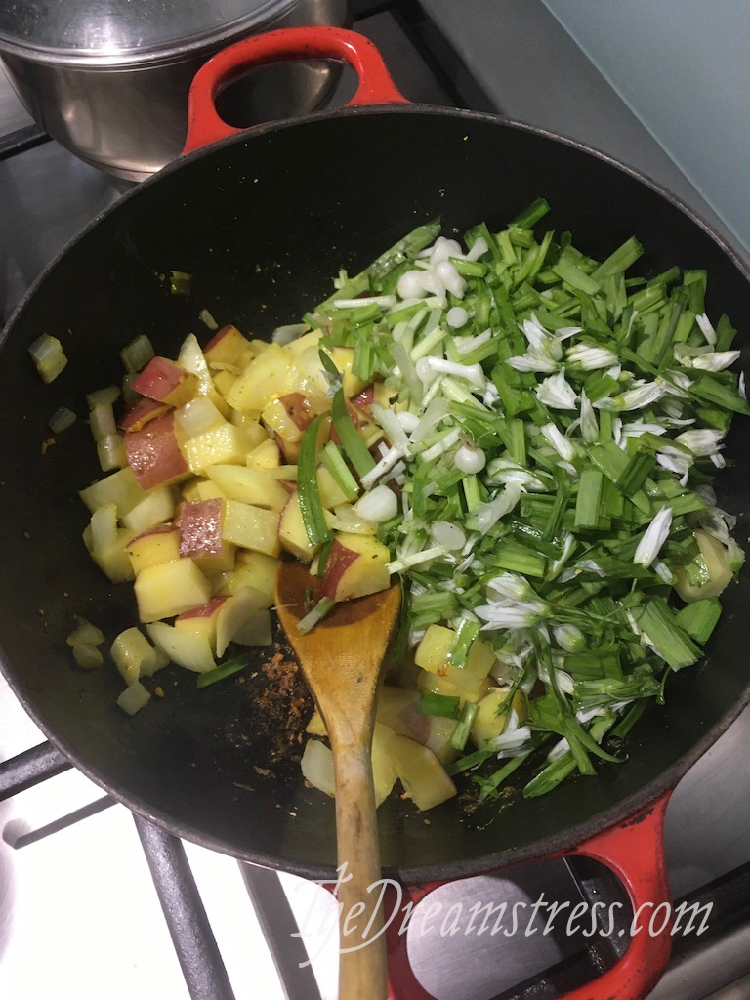
My recipe is a heavily altered hack of the one I’ve linked to in the heading – but it resembles the recipe less and less every year! We’ve been making it so long that it keeps evolving.
I omit the carrot, and use two potatoes instead. In winter I use wild garlic instead of onion. I use a vegetarian stock (homemade or good quality broth powder, depending on what I have on hand), use three courgettes (zucchini) instead of one, and add a cup and a half or two of cooked chickpeas or cannellini beans. I add spinach or kale instead of lettuce. When Mr D makes it he likes to add celery as well. Sometimes in summer when tomatoes are cheap I make it with fresh tomatoes. Sometimes I add a handful of fresh basil at the end. It’s the soup version of the thing you make with whatever’s on hand.
The one thing I don’t do is the croutons!
Moroccan Style Vegetable & Chickpea Soup
I found this recipe thanks to Loren of A Costumer’s Closet.

I find that the coconut oil really adds to the flavour of the soup, and it doesn’t taste right in another oil. We prefer it with Owairaka red or Toka Toka gold kÅ«mara (sweet potatoes) instead of the big orange Beauregard ‘yam’ variety. We also prefer it without the dates (you will find that omitting sugary things is a common alteration in our cooking).
I love that it just says ‘a handful of greens’ – allowing you to use whatever you have on hand which sounds good. I usually end up using a not-very-curly kale variant which is self seeding in my garden, and which I call dragon kale, because it’s a little more exciting than dinosaur kale!
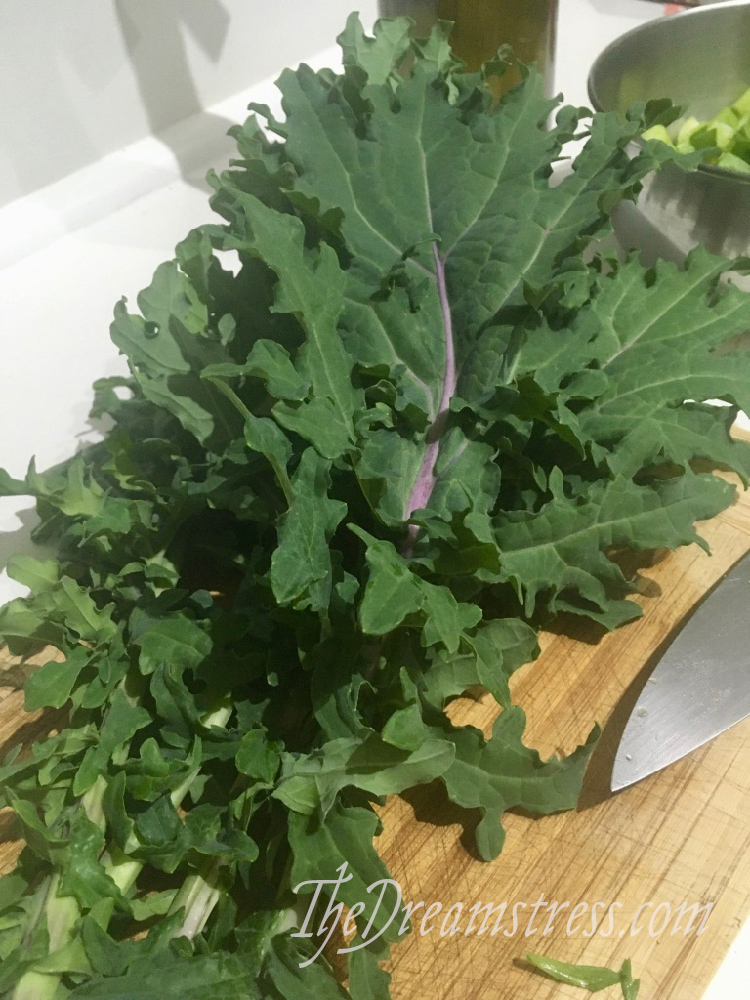
Green Lentils & Greens
Dragon kale also makes a frequent appearance in this dish, a hack of something my sister made as a side dish for a dinner party we threw when she was visiting. It’s such a simple dish, but it outshone the elaborate meat dish she made, and received far more rave reviews and requests for the recipe.
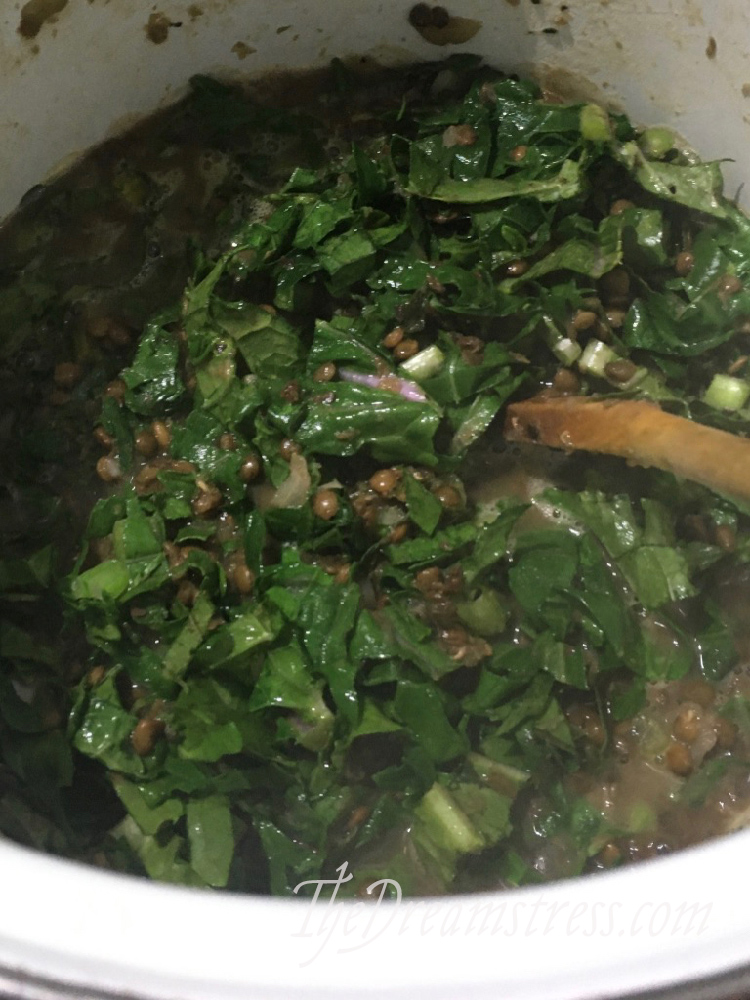
Basically you cook a couple of onions down very slowly in oil, add green puy lentils and sufficient stock (I use about 1.5cups lentils, 5 cups stock) and cook until the lentils are soft, and then add a couple of cups of finely chopped kale.
The trick is good quality stock, and the result is hearty and comforting, and super easy to make!
Lentil Butternut Squash Soup
New Zealand’s most-commonly-read-but-increasingly-hysterical-and-irrelevant news site published the story of the nurse who ate this soup for 17 years straight just before NZ went into lockdown. I saved the recipe, because the mix of spices and vegetables sounded intriguing. I can’t say that I’d eat it every workday lunch for 17 years, but it’s a nice addition to the menu once a fortnight.
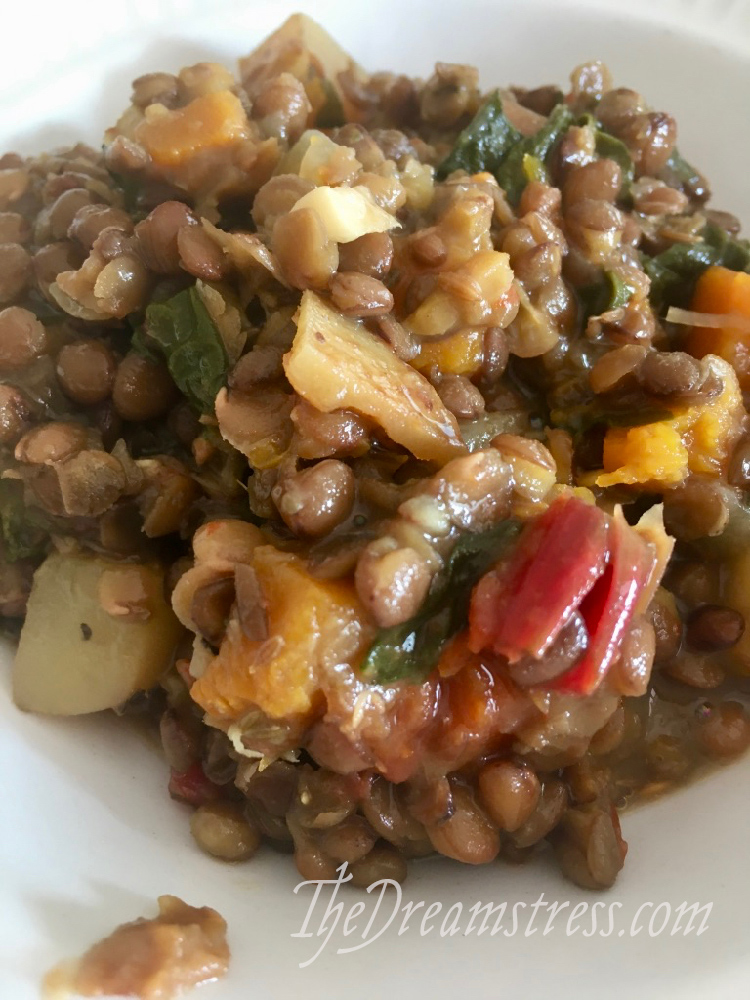
The recipe is interesting, because you can really see how preferences in cooking techniques have changed since 1992. It’s another great basis for playing with ingredients though. As long as you keep the spices the same, it survives a lot of substitutions to work with what’s in your fridge. And the spices are such fun…
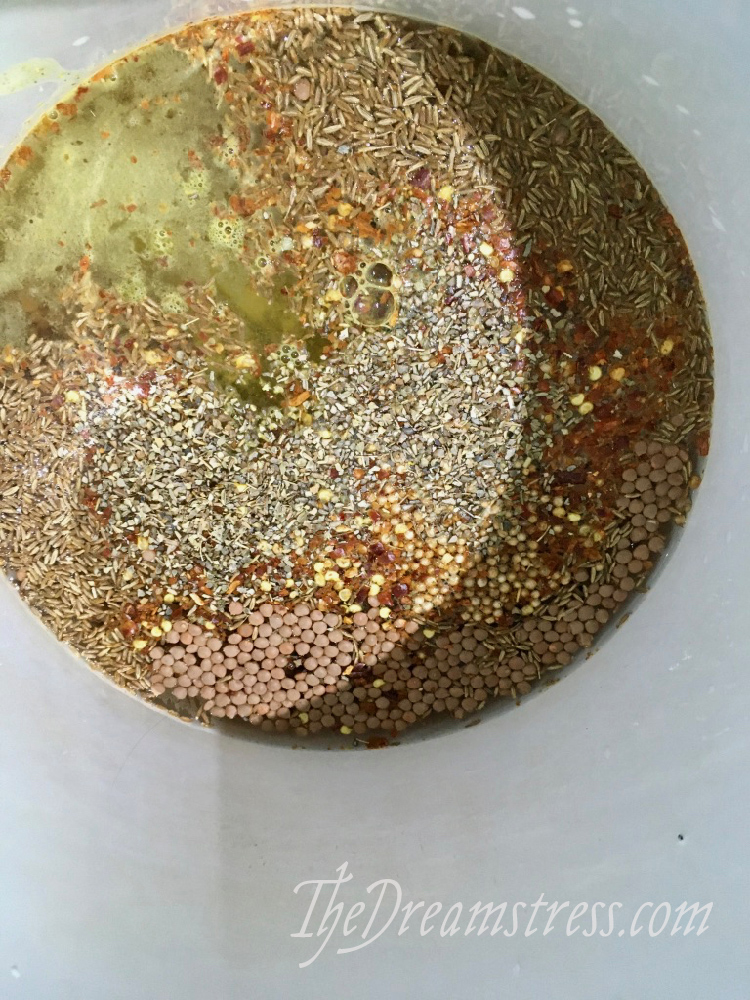
The recipe doesn’t specify what kind of lentils, but I’ve always used brown.
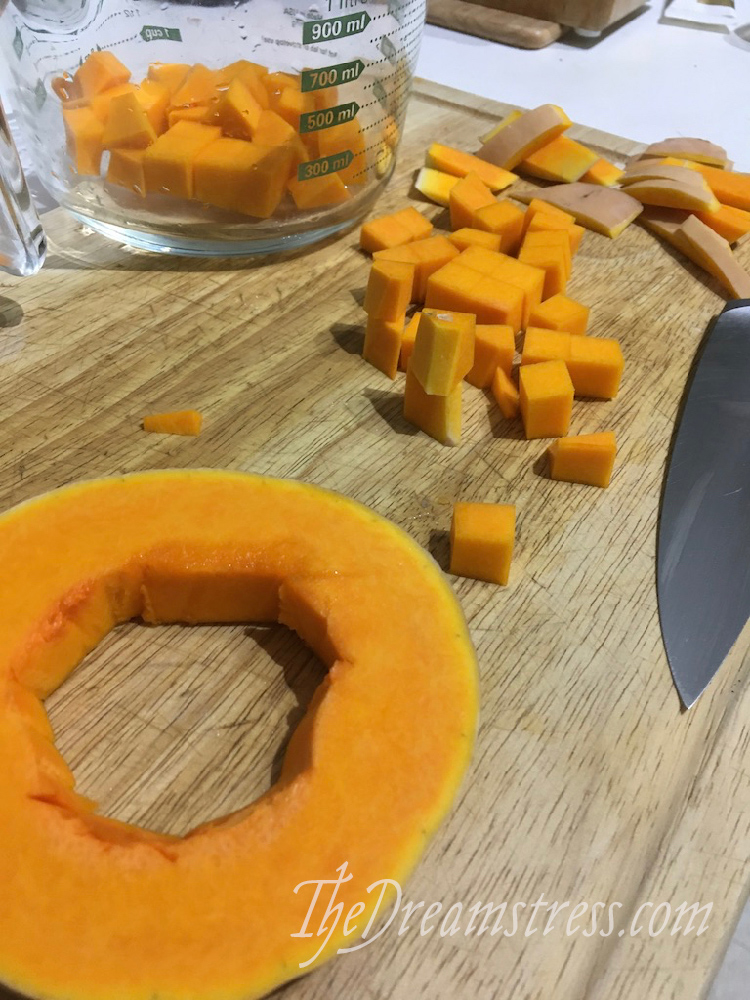
We’ve found that we prefer crown pumpkin to butternut squash in the soup – which is quite good because pumpkins are a fraction of the price!

I also prefer to add the spinach at the very end, instead of at the same time as the potatoes, when it just ends up cooking until it’s dead and flavourless. Even better, I prefer to sub out the spinach for kale, or ruby silverbeet (ruby chard). It adds a glorious dash of red colour, and you can saute the stems with the celery, or in place of the celery.
Rice Cakes
Not to be confused with the flavourless puffed-rice crackers, rice cakes are a family recipe, and quite possibly the only thing my mother cooks that her mother cooked.
Rice cakes are a way to use up leftover rice: add enough egg to hold it together (about 1 large egg to 1 cup of cooked rice/veg), and fry it up in patties.

My grandmother apparently made hers plain and ate them with butter, but my generation’s version has an Japanese twist courtesy of growing up in Hawai’i: we add a range of minced vegetables, and eat them with shoyu (soy sauce). I could see them made with peppers and coriander (cilantro) and served with avocado and salsa too…

Suitable vegetable additions include:
- Herbs like thyme, parsley & sage
- Mushrooms
- Spicy vegetables like mustard & kai choi, to give them a little bite and zing
- Shallots or green/spring onions, or wild garlic
- Cabbage
- Celery
We eat these for breakfast or lunch, and make them with long grain brown rice, the rice of choice in the House of Dreams.
They can also be made with buckwheat, which I’m using more and more as a rice alternative. Rice has the highest carbon footprint of any of the grains, because the paddies it’s grown in produce methane. Buckwheat had a very low carbon footprint, lots of great vitamins and nutrition, and a delicious nutty flavour. I told Miss 3 who was visiting that it was ‘pink rice’ to get her to eat it, and then got a phone call from her mother desperate to know what ‘pink rice’ was because Miss 3 didn’t want to eat the regular kind any more!
Let me know if you make any of these! What are your favourite vegetarian/vegan recipes?

bbcgoodfoodme.comsimplyquinoa.comI’m one of those people who’s slowly introducing vegetarian food, and sometimes by accident – toast and Marmite (NZ because that’s very important!), a sandwich/salad for lunch, and a curry for dinner is a fast-track to a vegetarian (Mon)day.
Personal favourites include mushroom Wellingtons (https://www.bbcgoodfoodme.com/recipes/melty-mushroom-wellingtons/ remove camembert/replace; homemade pastry with only butter), a chickpea curry or two (any googled recipe seems to mostly work; yours is a definite one to try!), and a red lentil dal (https://www.simplyquinoa.com/vegan-red-lentil-dal/).
It often seems like the Internet says you have to be vegan/vegetarian completely, but that’s not always suitable for varying lifestyles, surroundings or mental headspace (this is the biggest thing for me; I’m not capable of entirely upending my life overnight). I’m currently expanding my repertoire for servings for me for lunch, and steadily introducing dinners to a sometimes-skeptical family.
oh, yes, i have been cooking more, and that is saying something because i cook every meal, every day, with the exception of tuesday lunch usually… i’m baking more bread, have sourdough going, making more yoghurt and paneer, and basically thinking about what to cook next when i’ve barely finished eating the last thing!
i love that you shared your standby recipes. my diet is mostly plant-based (i was a vegetarian for many years, and generally prefer that), but hubby is resolutely carnivorous. so we try to make that less impactful—in all possible ways—by not having meat daily, and often choosing recipes that use a little meat to go a long way, by using every part from skin to bones, by buying only local and humanely raised meat/dairy whenever possible, and keeping portions small when we do eat it. he balked at first, but has been gradually seduced by good veg cooking and the greater quality of the meat he does get. every bit helps, and i think it’s nice to build bridges rather than shaming people. my experience is that if the food is good, nobody notices it doesn’t have meat, or don’t care much.
my favourite or go-to veggie recipes are kadhai paneer, simple but very highly spiced, long-simmered dals with home-made parantha or naan, any especially delicious goat or sheep cheese fried quickly in fine crumbs and served atop a rocket and fresh herb salad with fresh peas, radishes, or cucumbers in spring/summer. we do a fair amount of pastas that vary wildly according to seasonal vegetables on hand and mood. loads of soups. and loads of stews or “bowls”, too. i’ll cook anything that catches my interest, but my favourite cuisines tend to be indian, ethiopian, and moroccan. tagines, wats, biryanis, curries of all styles… oh dear, i’m hungry again.
as you use and like buckwheat…we make thin buckwheat crepes (savoury, usually, rather than sweet) and they are delicious with wats as a substitute for injera, as well as with sauteed greens, lentils, roasted veggies, or soft cheeses. or just gobs of butter, if not vegan. 🙂
i am definitely trying those rice cakes you describe above!
theguardian.comI know that I will be returning to this post very often to read the comments and incorporate ideas. Thank you all for the ideas so far. I hope you don’t mind me adding my humble go-tos. Lot’s of inherently gluten-free recipes above!
With celiac disease, we do order GF Schar bread directly from the company which, I swear, is almost as flavorful as “real” bread! But it quite expensive, so we don’t eat as much bread as we would like. We also tend to eat pasta made from lentils or chickpeas for the added protein and fiber.
As members of a CSA, we are delivered a box of local, seasonal veggies each week. It is great that so many of these recipes above are flexible. Usually, my formula is:
fat + allium + 2 vegetables + can of beans + zing
Olive oil, butter, or coconut oil depending on the origin of the food. Garlic, onion, shallot, scape. 2 or more vegetables (tonight is mushrooms and curly kale and a tin of tomatoes), can of canneli, pinto, chickpea, or leftover lentils. Lemon rind and juice, vinegar, brewers yeast, marmite, chiles.
But some of my very favorites are:
Diced fennel, cucumber, green pepper with some lemon on top (and spice, if you like) for a raw salad
Leftover lentils over lettuce and fresh tomatoes and canned fish
Mushrooms fried in butter, with lemon and parsley
Colcannon in any variation
Zuchini and summer squash roasted, serviced with lemon rind, and pine nuts
The Guardian Food column started promoting a more plant-based diet following the paper’s commitment to engage with global warming. They also started focusing on meat-as-special, and how to use up odds and ends to avoid food waste.
Then, they started really interesting columns for the pandemic: Baking without flour, cooking with pantry staples, very very cheap cooking, common recipes with substitutions for commonly-missing items. (They also do a lot of Australian contributors along with UK and North American ones)
https://www.theguardian.com/food
Looking forward to reading and trying more!
“New Zealand’s most-commonly-read-but-increasingly-hysterical-and-irrelevant news site” – I know exactly the one you mean! More like a magazine than an actual source of news, in my opinion.
One thing that always strikes me as weird about the “how to eat for the good of the planet” articles I see (e.g. on more reputable news sites) is the odd assumption that everyone in every different part of the world should be eating the same amounts of each kind of food, regardless of what is naturally available in their area. Like ecosystems and food miles and all the rest of it are just some minor details that can be brushed aside.
“Everyone should eat what is ethically available locally” makes a lot more sense to me than “everyone should eat xyz because it is the ethical diet”.
Also: yay for onionweed! (I think that’s the same thing as your wild garlic, judging by the pictures. Kind of smells like garlic, tastes like onion, right?) We use it in gá»i cuốn and the odd salad. I wish there was more of it in the garden.
Exactly that! About the local availability!
These are all intriguing, and unfortunately for me falling firmly into the area of cooking called “when you have time and space to search for ingredients.” 😀 I guess regular offer in NZ shops is different from regular offer in Czech shops… especially if we’re talking small town Czechia. To be honest, what corona-cooking mostly drove home for me was how spoiled for choice I’ve become by living close to a larger city in recent years…
… being stuck in a small town further away from a big city, for me, corona-cooking involved lots and lots of potatoes and onion, with an occasional dash of root vegetables or sauerkraut. Lentils (and other legumens) were involved, too, but not quite in these food variants…
… and some of the spices commonly used in curries and other types of Asian-style cooking are also in the “harder to find in small town Czechia” category.
Also my cooking isn’t vegetarian / vegan by any stretch. Vegan would be difficult to pull off for me with my cooking habits / traditional Czech cuisine, although I could, and did, definitely whip up a couple vegetarian dishes out of my usual repertoire no problem, if you don’t mind dairy and / or eggs…
… traditional Czech potato soup could probably be easily made vegan if you used oil instead of butter for the sauteing in the beginning and the roux, but I have no idea what oil would taste good with it. 😀
Coconut? Nope (well, if I searched maybe I would find it, but the whole problem of corona-shopping was that you did not have much space for searching). Olive oil can be had. Butter, lard, sunflower oil. (Other kinds of oil can be had, too, but sunflower was what was already in the pantry.)
I used to have a home-grown source of lard, which in my opinion beats coconut oil from the other side of the planet any day… especially because it involved barter trade for sour cherries from our garden… I don’t have that source anymore sadly. Still, if I’m going to try buying food ethically, “local farmers” and “produced in the Czech Republic” are probably going to be involved in there somewhere if at all possible. 🙂
Also reading this I realised I tend not to have leftover rice lying around because I tend to only use rice for risotto. 😀 BUT – considering also the existence of arancini – maybe leftover risotto could be similarly turned into these rice cakes. 🙂
Anyway. I had already been thinking that I should share more of my tried-and-trued recipes, and seeing this, and the whole problem of local availability, I really think I should.
I, for one, would love to hear your tried-and-true recipes. And home-rendered lard is actually a pretty decent source of healthy fat. Also, I agree that potatoes are best in butter (see my colcannon suggestion). Honestly, I love Northern (including Eastern) European food. Root vegetables, lettuce and cabbage, cold-water fish, excellent sausage, cheeses….yum! And then every region seems to find such wonderful combinations. Again, I would love to read some of your tried-and-true.
Here in South Texas, we eat locally, and so the vegetables are different, of course. Traditional Mexican in all of its regions focuses on beans and vegetables and cheese and spice/herbs. Mexico has a cheese culture just like Spain. But Mexicans eat more eggs per capita than any other country because it is a cheap source of protein, although most Mexican food eaten by Americans features endless beef or pork or chicken. Fruit is spiced with chiles.
I think what is the most interesting about the various traditional diets (Mediterranean, New Scandinavian, Mexican, Inuit) is that they are so different from each other, and yet the practitioners are the most healthy! As Deborah says, eating local is more important than eating X despite the miles. And animal-husbandry done well is really a beautiful thing.
Squee! Looking forward to more reading.
Here’s the one I have already shared:
http://marmota-b.blogspot.com/2011/11/as-promised-sauerkraut-soup-with-sour.html
– which I did make a couple of times both because I love it and because it’s one of those “cook a big pot and eat for several meals” types of food.
Oh, that sounds lovely! I read it with interest, and I especially like the story of the food. If you ever have reason to visit me, I will cook you traditional Sonoran Mexican food.
Sauerkraut (all fermentation, really) is developing a renaissance here in the US. It has been neat to watch cooks experiment with different vegetable and herb combinations, especially with locally-available food.
I don’t expect to have a reason to visit, but you never know. 🙂 My cousin actually developed a big interest in Mexican food, to the point of going to a several-weeks-long traditional cooking course in Mexico, so I may ask him to cook me something one of these days when I have a chance to visit him, and try to think of you. 😉
Also there’s this thing that while I say “my cooking isn’t vegetarian by any stretch”… in a way maybe it already is way more vegetarian than many other people’s cooking / eating habits if all that advice one sees about eating less meat is any indication. Because those advice columns seem to operate on the assumption that people eat meat every day and can’t even imagine a meal without it, which is definitely not my case! 😀
No doubt your cousin learned some wonderful cooking! Mexican cuisine has been recognised as one of the Great Cuisines of the World, and I bet he found the experience to be soul-satisfying.
Of course, Mexico is also like France because each region has its own flavor. Sonoran food isnt the prettiest, but it has won a Unesco World Heritage Food designation.
Yeah, most traditional food doesn’t have meat in every meal. And yes, Americans do expect meat at mealtimes. Probably because our veggies lack the flavor found in other countries–like yours.
There are two strands to traditional Czech cuisine, the burgher one which can be pretty meaty, and the peasant one which often makes do without out of necessity. And then there are things that may be of newer date… like deep-fried cauliflower. 😀
But also historically there were always recipes for Lent, so that automatically makes for a lot of vegetarian recipes if you look into historical cookbooks!
I find it hilarious that on the article about the nurse, who is in his 60s, the photo they’ve used is of a man, clearly in his 20s, looking fondly at the camera!
My favourite quick and easy soup for lunches is tomato-lentil. I throw in some dried shiitake mushrooms for the taste and delightful meaty texture. Mmmmm.
This week I’ve been deputized to make potato-leek soup, though, which is lighter and more spring-y, and will use up the chopped leeks I stuck in the freezer three weeks ago and forgot about. Really, though, the store made us buy the leeks in 5 lb bunches. That’s a LOT of leeks!
That IS a lot of leeks, considering you can get a lot of meal just out of one large one! :O
Rice cakes!! My mother’s godmother used to make these for her, and then she made them for me when I was a kid. I’ve never seen anyone else make them, and I love the idea of adding things to them, I’m going to try that!
Thank you for the smile and the new recipe ideas 🙂
Raven
Miss 3 is adorable!!!
stetson.eduHi, A friend of my friend wrote an amazing vegetarian Georgian cookbook and everything I have made from it has been amazing. Plus her stories!!!! https://www.stetson.edu/today/2019/12/stetson-professor-gets-cooking-with-georgian-cuisine/ Not usually plugging cookbooks but I love love love this one!!